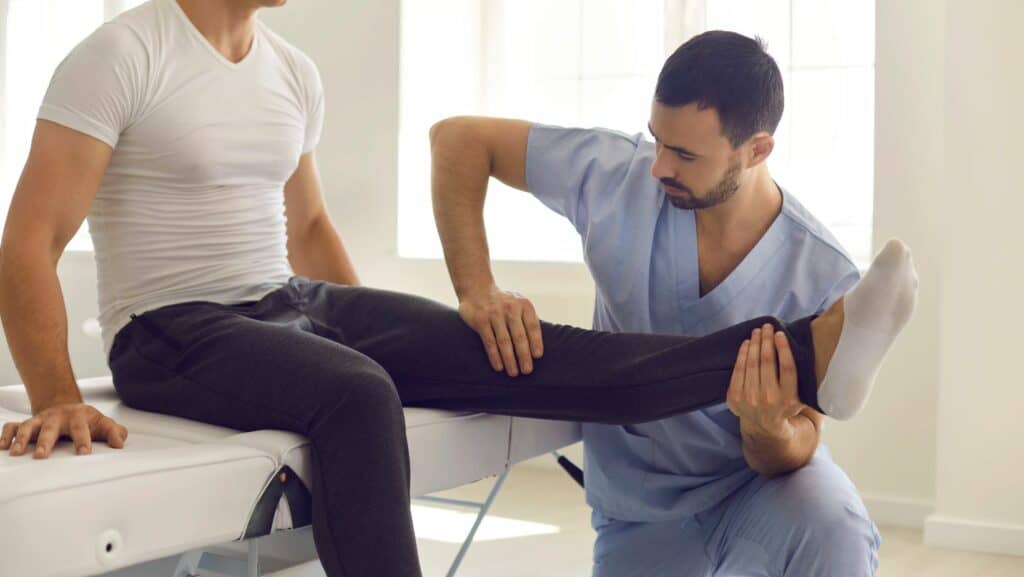A Lateral Collateral Ligament (LCL) rupture is an injury affecting the ligament on the outer side of the knee. The LCL is crucial for stabilizing the knee joint by resisting forces that push the knee inward and providing lateral support. When the LCL is ruptured, it can lead to pain, swelling, and instability, which can severely impact mobility and daily activities.
Understanding Lateral Collateral Ligament (LCL) Rupture
The LCL is a band of connective tissue that runs along the outer side of the knee, connecting the femur (thigh bone) to the fibula (the smaller bone on the outer side of the lower leg). It is responsible for stabilizing the knee during movement and preventing excessive side-to-side motion.
Causes and Risk Factors
An LCL rupture can occur due to various factors:
- Direct Trauma: A sudden impact to the inner side of the knee, such as from a collision in sports like football or hockey, can force the knee outward and cause an LCL rupture.
- Overuse or Repetitive Stress: Although less common, overuse or repetitive stress on the knee, especially during activities involving lateral movements, can strain the LCL.
- Sports Injuries: High-impact or contact sports that involve quick direction changes or collisions are particularly prone to LCL injuries.
Symptoms of LCL Rupture
The symptoms of an LCL rupture can vary based on the severity of the injury:
- Pain: Pain is typically felt on the outer side of the knee and may increase with movement or pressure.
- Swelling: The knee may swell, usually within the first 24-48 hours following the injury.
- Stiffness: The knee might feel stiff, making it difficult to fully bend or straighten.
- Instability: The knee may feel unstable or weak, particularly during weight-bearing activities or when moving sideways.
- Bruising: Bruising may appear around the outer side of the knee in some cases.
How Physiotherapy Can Help
Physiotherapy is vital in the management and rehabilitation of an LCL rupture. The aim is to alleviate pain, restore function, and strengthen the knee to support long-term recovery. The approach to physiotherapy depends on the severity of the LCL injury, which is classified into three grades:
- Grade I: Mild sprain with minor stretching of the LCL.
- Grade II: Partial tear of the LCL.
- Grade III: Complete tear or rupture of the LCL.
1. Pain and Swelling Management
Managing pain and swelling is a crucial early step in recovery:
- Rest and Activity Modification: Resting the knee and avoiding activities that exacerbate pain. Using crutches or a knee brace may be recommended to protect the knee.
- Ice Therapy: Applying ice packs to the knee helps reduce inflammation and numb pain, especially within the first 48 hours post-injury.
- Elevation and Compression: Elevating the leg and using a compression bandage can help control swelling and alleviate discomfort.
- Pain Relief Modalities: Techniques such as TENS (Transcutaneous Electrical Nerve Stimulation) and ultrasound therapy may be used to manage pain and support healing.
2. Restoring Range of Motion
Maintaining and restoring the knee’s range of motion is essential to prevent stiffness and ensure proper movement:
- Gentle Range of Motion Exercises: Exercises like heel slides and knee bends help to gradually restore movement without placing undue stress on the ligament.
- Stretching Exercises: Stretching the quadriceps, hamstrings, and calf muscles can improve flexibility and reduce tension around the knee.
3. Strengthening Exercises
Strengthening the muscles around the knee is crucial for stabilizing the LCL and improving overall knee function:
- Quadriceps Strengthening: Exercises such as straight leg raises, mini squats, and leg presses target the quadriceps to support and stabilize the knee.
- Hamstring Strengthening: Hamstring exercises like bridges and hamstring curls help balance the forces around the knee joint.
- Hip and Core Strengthening: Strengthening the hip and core muscles improves overall stability and movement patterns, reducing strain on the knee joint.
4. Balance and Proprioception Training
Improving balance and proprioception (the sense of joint position) is vital for knee stability and preventing future injuries:
- Balance Exercises: Activities like standing on one leg or using a balance board improve knee stability and coordination.
- Proprioceptive Training: Exercises that challenge the body’s ability to sense joint position, such as dynamic balance drills, enhance joint control and stability.
5. Gait Training and Functional Exercises
Re-training gait and practicing functional movements are essential for recovery and preventing re-injury:
- Gait Analysis: Evaluating walking patterns to identify and correct any abnormalities that may contribute to pain or instability.
- Functional Exercises: Practicing movements that mimic daily activities, such as climbing stairs or getting up from a chair, helps ensure the knee can perform these tasks without discomfort.
6. Education and Injury Prevention
Education is an essential component of physiotherapy for managing and preventing further injury:
- Activity Modification: Guidance on modifying or avoiding activities that place excessive stress on the knee joint.
- Footwear Advice: Recommendations for appropriate footwear or orthotics to support proper alignment and reduce knee stress.
- Home Exercise Program: A personalized exercise plan to continue strengthening and maintaining knee function outside of physiotherapy sessions.
Conclusion
An LCL rupture can significantly impact your daily life and physical activities, but with the right approach, recovery is achievable. Physiotherapy offers a comprehensive treatment plan that addresses pain, improves knee function, and supports overall recovery. By working with a physiotherapist, you can develop a personalized program to manage symptoms, restore mobility, and strengthen the knee, ultimately helping you return to your normal activities with greater ease and confidence. If you suspect you have an LCL rupture, seeking early intervention from a physiotherapist is crucial for achieving a successful recovery and preventing future issues.


